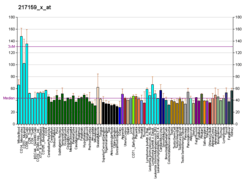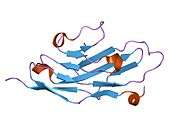| SIGLEC7 |
|---|
 |
|
| Identifiers |
|---|
| Aliases | SIGLEC7, AIRM1, CD328, CDw328, D-siglec, QA79, SIGLEC-7, SIGLEC19P, SIGLECP2, p75, p75/AIRM1, sialic acid binding Ig like lectin 7 |
|---|
| External IDs | HomoloGene: 130668 GeneCards: SIGLEC7 |
|---|
|
|
|
| Orthologs |
|---|
| Species | Human | Mouse |
|---|
| Entrez | | |
|---|
| Ensembl | | |
|---|
| UniProt | | |
|---|
| RefSeq (mRNA) | | |
|---|
| RefSeq (protein) | | |
|---|
| Location (UCSC) | Chr 19: 51.14 – 51.15 Mb | n/a |
|---|
| PubMed search | [2] | n/a |
|---|
| Wikidata |
|
Sialic acid-binding Ig-like lectin 7 is a protein that in humans is encoded by the SIGLEC7 gene.[3][4] SIGLEC7 has also been designated as CD328 (cluster of differentiation 328).
References
- 1 2 3 GRCh38: Ensembl release 89: ENSG00000168995 - Ensembl, May 2017
- ↑ "Human PubMed Reference:".
- ↑ Nicoll G, Ni J, Liu D, Klenerman P, Munday J, Dubock S, Mattei MG, Crocker PR (Dec 1999). "Identification and characterization of a novel siglec, siglec-7, expressed by human natural killer cells and monocytes". J Biol Chem. 274 (48): 34089–95. doi:10.1074/jbc.274.48.34089. PMID 10567377.
- ↑ "Entrez Gene: SIGLEC7 sialic acid binding Ig-like lectin 7".
Further reading
- Reif K, Buday L, Downward J, Cantrell DA (1994). "SH3 domains of the adapter molecule Grb2 complex with two proteins in T cells: the guanine nucleotide exchange protein Sos and a 75-kDa protein that is a substrate for T cell antigen receptor-activated tyrosine kinases". J. Biol. Chem. 269 (19): 14081–7. PMID 8188688.
- Falco M, Biassoni R, Bottino C, et al. (1999). "Identification and molecular cloning of p75/AIRM1, a novel member of the sialoadhesin family that functions as an inhibitory receptor in human natural killer cells". J. Exp. Med. 190 (6): 793–802. doi:10.1084/jem.190.6.793. PMC 2195632. PMID 10499918.
- Ye X, Mehlen P, Rabizadeh S, et al. (1999). "TRAF family proteins interact with the common neurotrophin receptor and modulate apoptosis induction". J. Biol. Chem. 274 (42): 30202–8. doi:10.1074/jbc.274.42.30202. PMID 10514511.
- Vitale C, Romagnani C, Falco M, et al. (2000). "Engagement of p75/AIRM1 or CD33 inhibits the proliferation of normal or leukemic myeloid cells". Proc. Natl. Acad. Sci. U.S.A. 96 (26): 15091–6. doi:10.1073/pnas.96.26.15091. PMC 24778. PMID 10611343.
- Angata T, Varki A (2000). "Siglec-7: a sialic acid-binding lectin of the immunoglobulin superfamily". Glycobiology. 10 (4): 431–8. doi:10.1093/glycob/10.4.431. PMID 10764831.
- Ito A, Handa K, Withers DA, et al. (2001). "Binding specificity of siglec7 to disialogangliosides of renal cell carcinoma: possible role of disialogangliosides in tumor progression". FEBS Lett. 498 (1): 116–20. doi:10.1016/S0014-5793(01)02476-0. PMID 11389909.
- Mingari MC, Vitale C, Romagnani C, et al. (2002). "Regulation of myeloid cell proliferation and survival by p75/AIRM1 and CD33 surface receptors". Adv. Exp. Med. Biol. 495: 55–61. doi:10.1007/978-1-4615-0685-0_8. PMID 11774609.
- Yousef GM, Ordon MH, Foussias G, Diamandis EP (2002). "Genomic organization of the siglec gene locus on chromosome 19q13.4 and cloning of two new siglec pseudogenes". Gene. 286 (2): 259–70. doi:10.1016/S0378-1119(02)00432-8. PMID 11943481.
- Alphey MS, Attrill H, Crocker PR, van Aalten DM (2003). "High resolution crystal structures of Siglec-7. Insights into ligand specificity in the Siglec family". J. Biol. Chem. 278 (5): 3372–7. doi:10.1074/jbc.M210602200. PMID 12438315.
- Strausberg RL, Feingold EA, Grouse LH, et al. (2003). "Generation and initial analysis of more than 15,000 full-length human and mouse cDNA sequences". Proc. Natl. Acad. Sci. U.S.A. 99 (26): 16899–903. doi:10.1073/pnas.242603899. PMC 139241. PMID 12477932.
- Nicoll G, Avril T, Lock K, et al. (2003). "Ganglioside GD3 expression on target cells can modulate NK cell cytotoxicity via siglec-7-dependent and -independent mechanisms". Eur. J. Immunol. 33 (6): 1642–8. doi:10.1002/eji.200323693. PMID 12778482.
- Dimasi N, Moretta A, Moretta L, et al. (2004). "Structure of the saccharide-binding domain of the human natural killer cell inhibitory receptor p75/AIRM1". Acta Crystallogr. D. 60 (Pt 2): 401–3. doi:10.1107/S0907444903028439. PMID 14747738.
- Ikehara Y, Ikehara SK, Paulson JC (2004). "Negative regulation of T cell receptor signaling by Siglec-7 (p70/AIRM) and Siglec-9". J. Biol. Chem. 279 (41): 43117–25. doi:10.1074/jbc.M403538200. PMID 15292262.
- Avril T, Floyd H, Lopez F, et al. (2005). "The membrane-proximal immunoreceptor tyrosine-based inhibitory motif is critical for the inhibitory signaling mediated by Siglecs-7 and -9, CD33-related Siglecs expressed on human monocytes and NK cells". J. Immunol. 173 (11): 6841–9. doi:10.4049/jimmunol.173.11.6841. PMID 15557178.
- Yamaji T, Mitsuki M, Teranishi T, Hashimoto Y (2005). "Characterization of inhibitory signaling motifs of the natural killer cell receptor Siglec-7: attenuated recruitment of phosphatases by the receptor is attributed to two amino acids in the motifs". Glycobiology. 15 (7): 667–76. doi:10.1093/glycob/cwi048. PMID 15703304.
- Attrill H, Takazawa H, Witt S, et al. (2006). "The structure of siglec-7 in complex with sialosides: leads for rational structure-based inhibitor design". Biochem. J. 397 (2): 271–8. doi:10.1042/BJ20060103. PMC 1513286. PMID 16623661.
- Rapoport EM, Pazynina GV, Sablina MA, et al. (2006). "Probing sialic acid binding Ig-like lectins (siglecs) with sulfated oligosaccharides". Biochemistry Mosc. 71 (5): 496–504. doi:10.1134/S0006297906050051. PMID 16732727.
- Biedermann B, Gil D, Bowen DT, Crocker PR (2007). "Analysis of the CD33-related siglec family reveals that Siglec-9 is an endocytic receptor expressed on subsets of acute myeloid leukemia cells and absent from normal hematopoietic progenitors". Leuk. Res. 31 (2): 211–20. doi:10.1016/j.leukres.2006.05.026. PMID 16828866.
PDB gallery |
|---|
1nko: Energetic and structural basis of sialylated oligosaccharide recognition by the natural killer cell inhibitory receptor p75/AIRM1 or Siglec-7 1o7s: HIGH RESOLUTION STRUCTURE OF SIGLEC-7 1o7v: HIGH RESOLUTION STRUCTURE OF SIGLEC-7 2df3: The structure of Siglec-7 in complex with alpha(2,3)/alpha(2,6) disialyl lactotetraosyl 2-(trimethylsilyl)ethyl 2g5r: Crystal structure of Siglec-7 in complex with methyl-9-(aminooxalyl-amino)-9-deoxyNeu5Ac (oxamido-Neu5Ac) 2hrl: Siglec-7 in complex with GT1b |











